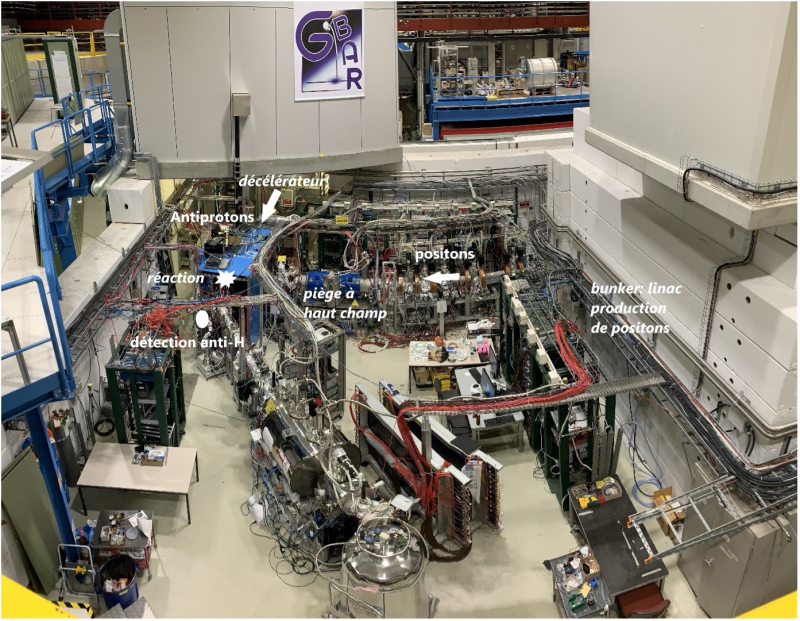Antimatter: CERN's GBAR experiment joins the anticlub!
CERN's GBAR experiment has just joined the very select club of experiments that have succeeded in synthesising antihydrogen atoms. This is a major milestone for the GBAR collaboration, whose aim is to measure whether antimatter behaves identically to matter in the Earth's gravitational field. French groups from CNRS and CEA are deeply involved in the experiment.
The ultimate aim of the GBAR (Gravitational Behaviour of Antihydrogen at Rest) experiment is to measure the acceleration of an antihydrogen atom in the Earth's gravitational field, and compare it with that of ordinary matter: a crucial test of the equivalence principle underlying Einstein's general relativity. But preparing an antiatom slow enough to see it "fall" is no mean feat. GBAR's approach is to first produce an antihydrogen atom and then turn it into a positive ion (the antimatter equivalent of an H- ion). Then the ion can be slowed down using quantum-optical techniques. Finally, the ion is neutralised for free-fall measurement. The collaboration announced the successful production of its first antiatoms at the Moriond meetings in March 2023.
To achieve this, the team has developed a complex protocol in which anti-hydrogen atoms are assembled from antiprotons produced by the Antiproton Decelerator (AD), and positrons produced in GBAR. The AD's 5.3 MeV antiprotons are decelerated and cooled in the ELENA ring and a packet of a few million 100 keV antiprotons is sent to GBAR every 2 minutes. In GBAR, a 100 kV pulsed drift tube further decelerates this packet to an adjustable energy of a few keV. In parallel, in another part of GBAR, a linac sends 9 MeV electrons onto a tungsten target, producing positrons, which are accumulated in a series of electromagnetic traps. Just before the antiproton pulse arrives, the positrons are sent to a layer of nanoporous silica, from which about one in five emerges as a positronium atom (Ps, the bound state of a positron and an electron). When the antiproton packet crosses the Ps cloud, a charge exchange can take place: the positronium gives up its positron to the antiproton, forming antihydrogen.
Almost twenty antihydrogens detected
At the end of 2022, during an operation lasting several days, some twenty antihydrogen atoms produced in this way were detected, validating this "in-flight" production method for the first time.
After this essential first step, the GBAR collaboration will now improve the production of antihydrogen atoms. This will enable precision measurements to be made on the antihydrogens themselves, in particular the energy gap between two very specific atomic levels, known as the Lamb shift. This measurement will give a more precise value for the radius of the antiproton. This will be followed by the production of positive antihydrogen ions, which will require even greater performance from the two beams, and finally the implementation of the laser systems for cooling these ions and photo-detaching a positron, to finally observe the free fall of an antihydrogen atom.

GBAR is not alone in its attempt to defy Einstein's equivalence principle: two competing experiments at the AD are pushing hard to determine if antihydrogen might fall upwards. ALPHA, a pioneer in the synthesis and trapping of neutral antihydrogen, is the most advanced. The other experiment, AEgIS, produces antihydrogen using the same reaction as GBAR with positronium. It aims to detect a possible sagging trajectory of the flying antiatoms with a sensitive interferometer.
The GBAR collaboration is composed of 18 institutes from 9 countries, and is led by Patrice Perez from Irfu. The French laboratories involved are IJCLab in Orsay (IN2P3), LKB in Paris (INP), Irfu in Saclay (CEA), Institut Laue Langevin in Grenoble and Institut de Physique et Chimie des Matériaux in Strasbourg.
CERN, antiatom factory since 1997
GBAR is not the first experiment to produce antihydrogen: the first production at CERN's LEAR facility in 1997 produced 7 antiatoms but at an energy too high for any measurement. With this early success, CERN's Antiproton accumulator (used for the discovery of the intermediate vector boson in 1983) was repurposed as a decelerator, becoming the AD, unique worldwide in providing low energy (5 MeV) antiprotons to users. After the demonstration of holding antiprotons by the ATRAP and ATHENA experiments, the ALPHA experiment was first to merge trapped antiprotons and positrons and trap the resulting antihydrogen atoms. Since then, experiments on the neighboring beamlines ATRAP, AEgIS and ASACUSA have also achieved this milestone. GBAR now joins this elite club, having produced 6 keV antihydrogen atoms in flight. Rather than storing the ingredients and gently bringing them together, GBAR produces antihydrogen as a low energy beam that is then transported through downstream apparatus for precision measurements.
Read more
- GBAR Collaboration preprint: https://arxiv.org/abs/2306.15801
- GBAR webpage https://home.cern/fr/science/experiments/gbar
- The Antiproton decelerator https://home.cern/science/accelerators/antiproton-decelerator
